Banded Krait
Banded Krait (Bungarus fasciatus)
These are yellow and black kraits here in Thailand. In some other part of the world (Borneo) they are black and white. There are also “Blue Kraits“ aka “Malayan Kraits” which are black and white. And the really incredible looking Red-headed Krait which looks nothing like either of them.
[Last updated: 14 July 2023]
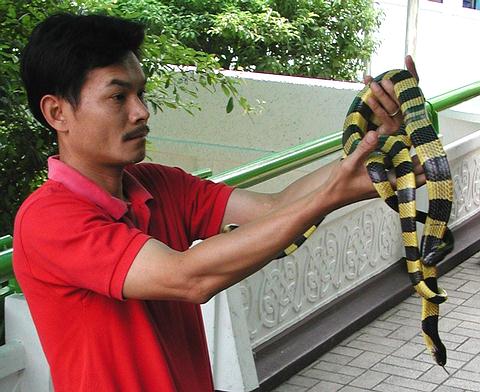
Bungarus Fasciatus (Banded Krait)
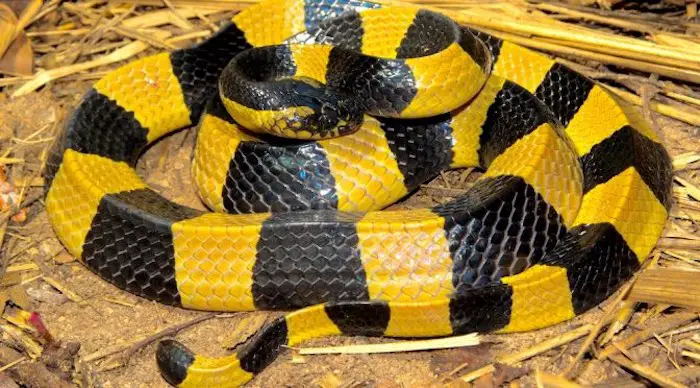
Thais say: (ngoo sam lee-um, or ngoo kan plong) This is a bit confusing in Thailand where in southern Thailand any viper is known as Ngoo sam lee-um. Lee-um means triangle, and so some people confuse the triangle-shaped heads of the vipers with the triangle cross-sections of the kraits.
Length: average 1.5 m up to 2 m (about 6.5 feet) In Thailand they don’t usually reach a full 2 meters, but I have seen one that was just over 2m.
Range: All over Thailand and most of Asia. Never found in Krabi province, oddly enough.
Notes: Banded kraits are secretive, meaning they are mobile at night and prefer grass or other greenery to hide them. I have seen a few dead on the roads – but I don’t go digging up ratholes or termite mounds. I may start if I don’t find one soon.
I’ve been looking for three years to find a krait with yellow and black bands like these.
At dinner last night I was looking around a small restaurant with many ponds, for snakes. I asked the owner’s son if they had seen any. He said, Ngoo Sam lee-um. That could be the one. I’ll get their permission for some late-night herping and try to bag one.
I’m sure they’ll appreciate it. This restaurant is located on a small hill close to sea level in southern Thailand. There are many frogs at the ponds, and probably many snakes too.
Update 2021- I’ve been to that restaurant numerous times and have not had a call from them about this krait. I am not sure they have been found in Krabi. I have never found roadkill B. fasciatus here in Krabi.
I have found a large 2-meter banded krait dead on the road banded krait in Surat Thani on the main highway leading to Krabi.

Habitat: This Thailand krait lives on the ground and in rat holes and termite mounds, under stumps or rocks and in other cool, damp places. Recently I saw photos of one in some limestone rocks here in Thailand. They prefer wide-open areas near water.
Rice fields and mangrove areas are the best places to start looking for them at night.
They have been found as high as 1,524 meters in Malaysia and about 2,300 meters in Thailand.
Active Time? The snake is mostly nocturnal and is quite active at night. Most bites occur at night, as the kraits move close to people sleeping – usually on the floor, and probably the person moves and the krait bites. More dangerous at night, during the day they are not biters. These kraits are common in the northeast Thailand provinces.
Recently a six-year-old boy was bitten and could not be revived. The snake had come up into their home in Surin to escape some flooding.
Food: Other snakes almost exclusively – rat and cat (Boiga) snakes. In captivity, I have seen them eat the following live snakes: Calloselasma rhodostoma, Chrysopelea ornata, and Gonyosoma oxycephalum. One noted herpetologist states that these kraits don’t like to eat water snakes.
Will also eat rats, mice, frogs, lizards if snakes cannot be found.
Defensive Behavior: The banded krait is slow acting during the day, lethargic, and usually not interested in striking. However, it can protect itself quite well – it is a strong biter and has been recorded as killing a large type of cattle 60 minutes after a bite.
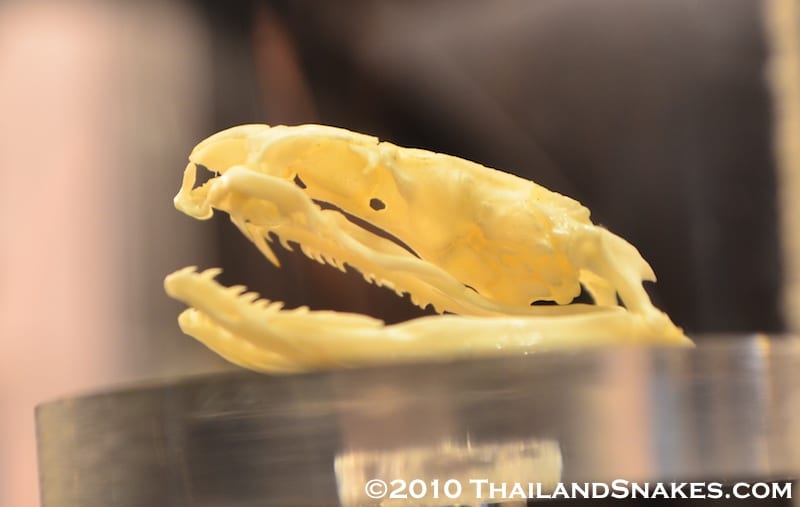
Banded Krait skull showing fangs, jaw, and other dentition. Skull located at Queen Saovabha Memorial Institute in Bangkok, Thailand. ©Vern Lovic.
Venom Toxicity: Very toxic. Deadly. This yellow/black banded krait from Thailand appears to have venom that is very toxic to humans. The typical LD-50 studies to assess the toxicity of venom in mice, rate this as a very toxic venom as well.
These snakes rarely bite during the day, but if they do, they can transfer enough venom to kill you. I read about a person dying in 30 minutes, and another dying in 15 hours.
A famous American herpetologist, Joe Slowinski, was killed by a baby krait (Bungarus multicinctus) in Burma while on a remote expedition. He finally succumbed after 30 hours. They can be quite deadly.
The cause of death is that your muscles are paralyzed and your diaphragm can’t work any longer to pull oxygen into your lungs.
Kraits are very deadly in this regard. However, if you are able to get to a hospital with a ventilator you will likely be OK. There is no specific antivenin for snake bites from this snake, but polyvalent venom is used – which can also treat bites from Naja kaouthia and Ophiophagus hannah.
Interesting to note… when fed on a live garter snake the krait venom acts instantly to cause death. Apparently, krait venom is very efficient with snakes – the krait’s primary diet.
Handling: The banded and Malayan blue kraits are not known to bite during the daytime. However, at night time they bite rather easily, as evidenced by the numerous krait bites that occur at night to people usually laying down to sleep on the floor either outdoors or in their homes with the door open.
I would never handhold kraits like the man is doing in the photo above. The krait venom is so toxic, it’s just not worth the risk – however small. Their venom is stronger than that of monocled cobras.
Antivenin: Polyvalent. It is advised by experts to get antivenin in your bloodstream for krait bites before you have symptoms because once symptoms develop you may have lost nerve functioning that will likely not return.
Offspring: Mating in March-April and 4-14 eggs laid about 60 days afterward. The mother krait remains with the eggs for another 60 days before they hatch. Baby kraits are about 30cm long at birth and have venom.
I couldn’t find in the literature whether the mother left the eggs as they started hatching – so she didn’t eat them herself or not. The King Cobra does this instinctively because it also eats other snakes.
Update: I was contacted by a man who was bitten by this same type of krait during the night (midnight) at an impromptu show at a bar in Bangkok. The snake handler let him hold it and it bit his arm deeply. He was lucky to live and had lingering effects for more than five years after the bite!
Banded Krait Scientific Classification
Kingdom: Animalia
Phylum: Chordata
Subphylum: Vertebrata
Class: Reptilia
Order: Squamata
Suborder: Serpentes
Family: Elapidae
Genus: Bungarus
Species: B. fasciatus
Binomial name
Bungarus fasciatus
Classified by Schneider in year 1801
Photo of Two Adult Banded Kraits:
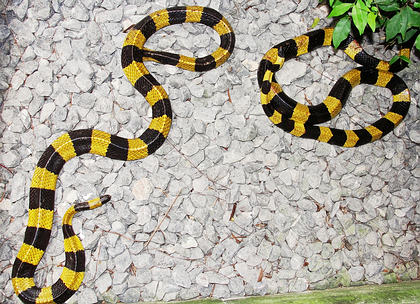
Video of Jackie with Banded Krait from Nakhon Si Thammarat, Southern Thailand:

Venomous Snakebites and Near Misses!
More than 34 stories of venomous snakebites and very near misses from Southeast Asia’s most deadly snakes – King Cobra, Malayan Pit Viper, Monocled Cobra, Banded Krait, Malayan Krait, and more! Digital Book with over 100 pages by Vern Lovic.

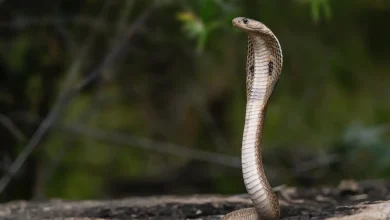
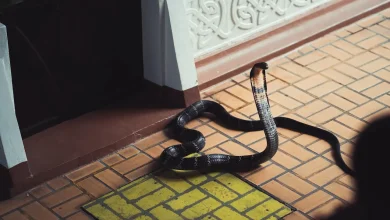
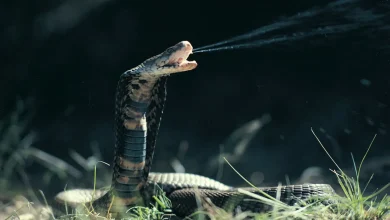
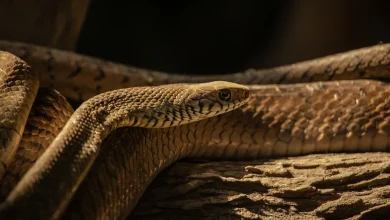
Hello,
Just saw a big/fat snake about 2 mtr in my garden here in Hua Hin.
Yello with black stripes and went into the waterhole next to my house.
So i look it up on the internet and saw his pictuire on your site.
Scary to know that he is very dangerous so i hope he leave and i don”t see him again.
Thanks for the pic and info!
George.
The Kraits are deadly, but the thing is – they don’t bite unless you mess with them directly or step on one. Their venom is more deadly than the monocled cobras – which are more deadly than the King Cobra. So – give the kraits some space or call the snake guys in your area to pick it up. I know a guy that is sometimes in Hua Hin that would LOVE to catch that snake for you – but, unfortunately he went back to Belgium for now. 2 meters is about as big as these get, you have a nice specimen there!
We had black and white one in our children’s bedroom! We live in a remote forested area near Khao Yai park in Korat. It was midnight and we were sleeping. Not knowing the danger, our teen age children killed it, then woke us up. We looked on line and compared the specimen with many pictures and found it was the banded krait! We said thankful prayers that night!
Wow Dawn, that is a scary story. Apparently people are bitten at night when they sleep because the kraits are active at night and tend to get in the beds with people. Especially if cold. The Snake Charmer, is a book about Joe Slowinski, a snake expert that was bitten by a baby krait – and died from it. They are ultra- deadly and you should figure out where that snake got into your house and seal up all entry points. Hopefully there are not more. Good luck to you. Any photos?
I’m sorry I just now read your reply because I was looking up banded kraits again since I almost stepped on another very long one tonight! We seem to have no shortage of banded kraits here. The krait tonight was black and white striped. I’ve not seen any yellow and black ones here. I regret I didn’t get any photos of the one in the children’s room, I was too upset to think about that. The one tonight was outside in the dark, half hidden in the grass, so my camera wouldn’t have picked it up.
Wow. Get some pics. Are these around 1 meter or longer, or how big?
Well that’s a nice and beautiful snake..but i just need to tell you something..The banded krait is deadlier than the monocled cobra..even to humans..Krait venom is 16x more potent than cobra venom..but it may be lesser or more..depending on the cobra..but still,krait venom is more potent then cobra venom *than*..Anyway happy herping like me!
Hi Muhd,
Where did you get that info? The Bungarus fasciatus is a 3.6 on the LD 50. Naja naja are .45. Lower the number, higher the toxicity of venom. Cheers, Vern.
I got it at wikipedia..but other websites had also said that..Btw what you are talking about is that cobras are more toxic and kraits,which is true..but kraits have more potent venom.
Cheers ^_^
I’m laying in my tent reading this page after seeing a black and white krait go into the kids tent that are with us I just shone my torch over to help them get in and seen the tail just disappearing into the tent (did tell them to keep it zipped up all the time ) . Anyways a local guy with us grabbed it by the tail and threw it out of the tent he told us it would be bad karma to kill it ? I’m in Sakon nakhon staying on some recently cleared land within 10m of some jungle
That’s a scary thing Stuart. How do you know it was a krait? How big was the snake? How thick? That’s pretty crazy of the local guy to pick it up by the tail unless he knew what he was doing. The kraits are pretty active at night – much more so than during the day time. Most bites happen at night as people are sleeping on the ground. Strange that it crawled right in the tent – but they do seek warm spots. Ok then – cheers, hope you get back to me.
Hi vern im pretty sure it was a banded Krait i have seen a few dead ones by the side of the road and also seen quite a few banded sea Kraits whilst diving around thailand and SE Asia (photos on FB) it had distinctive black and white bands around its entire lentgh.It was under 1m long and only about 10-15mm wide at a guess only a juvenile ?. I also seen a Python ? ( the locals said it squeezes its prey and wasn’t very dangerous) on the same land in the daytime again prob not that old about 1m or so long and a light grey shinny colour did see some shed skin near by might of just shed its skin. Also the day before while they were working on the land they seen a Cobra as well i think it maybe that the land has recently been cleared and maybe disturbed the local snake population ?. Also maybe a month or so ago i seen a very large dark brown/black snake heading across the road it was about 3m long it covered nearly one side of the road as it crossed no idea what it was as it was moving quickly it was late afternoon .There are quite a lot of snakes around here :-)
Wow, that is a LOT of snakes for this time of year – where exactly are you??????? I’m coming there tomorrow! Just joking, I’ve half a mind too though. Forget this having a family stuff – my snake time has been cut WAY short. lol.
Sounds like a great place… if you can email me really and let me know about where you are – GPS coordinates, anything you can tell me will help when I get out there.
Cheers man! Vern (info@thailandsnakes.com)
Long brown snake must be a rat snake
Respected Sir,
I am ATUL BARSAGADE studying in B.Sc final year (life science) at RTM Nagpur university India.I am working as a snakefriend in spare time by catching all type of snakes and ultimately releasing them to nearby forest.This is because I have much interest in snakes than any other animals.This e mail is with reference to the outcome of my surfing on internet for the professors of herpetology and herpetologists.
Sir I will be very happy if I can study HERPETOLOGY under your valuable guidance.It will definitely satisfy my thrust about snakes .I want to study about them in practical sense in their natural habitat.In this regard please inform me if I can study HERPETOLOGY in your laboratory.It will definitely encourage me to contribute in the conservation of snakes and lizards.
I would like to work under your valuable guidance.
Awaiting for your positive reply.
Kindly
Atul Barsagade
ADRESS:AT HANUMAN WARD No10
PO+TAH+DISTT:GADCHIROLI
PIN 442605
Mob:+91 0 8657365946
I responded by email. Just FYI to anyone else reading this comment. I am not a biologist. I am not respected in the field of herpetology. I am just a guy that loves going into Thailand’s forest and jungles and finding reptiles, amphibians, insects, and other animals.
If you want to come to Thailand and hang out here for a while, and we’ll go herping – great. If you want me to offer you expert instruction on something – that’s beyond me.
Cheers,
Vern
LOL Ya Vern you would not get me to hold a Krait like that LOL on a long hook ok, but never free handed, LOL you should post a few photos of what the bite looks like LOL, there are photos on the net LOL
Sorry, I have not yet finished reading your article. I just started to write this when I reached the line that you were asking to see the snake. I kind of saw 2m. long and about 5in girth of this snake around Baan Vieng Nuer, Pai, MaeHongSon, Thailand at some points in October 2012 (about the time that season changed from Rainy – monsoon, to dry season). Not only the huge size, I saw once, I also saw a few numbers of the 50cm long ones as well.
Amazing thing was, I saw them just not far/around the villagers’ places. The villagers seemed to let alone them rather than hunting them to death or to eat them. And that’s my first time to see such amazing stripes with my eyes and in wild(well, I count it in wild, since it’s not in the poor conditioned zoo somewhat.
—–
I save the world by being vegan!
I think sometimes the villagers are aware that the snakes eat the rats – these Kraits love rats, and live in the rat holes along the rice fields.
Please join our Facebook page at http://www.facebook.com/ThailandSnakes, when you get a chance! Thanks for your comment.
If you want to see one of these snakes in the wild just come to Chiang Mai near my house. This year I have seem 3 live ones and one huge one dead on the road. Tonight my dog was barking.. when I went out the front door.. with no shoes on.. there was a young banded Krait on the doorstep. It was only about 50 cm long.. and very beautiful.. I got some good photos. Not at all aggressive.. but I gave it plenty of space and I would NEVER try to handle or even catch them. I never go looking for these things.. but they seem to be attracted to me.. I have seen many strange and rare creatures by chance.. which many of my Thai friends.. who were born here.. have not even seen. Weird.
I found a small snake similar to this yellow banded krait. I searched the internet for it because I never saw a snake like this in our area. The snake was 160mm long and quite thin. I’m living in the Western Cape (150km outside Cape Town), South Africa. My question: If the yellow banded krait is only found in Thailand and Asia, what is this? I have taken photos and made a video of the snake.
I was bitten by a baby common krait and was admitted in hospital for 4 days. I got the necessary treatment. I want to whether the symptoms of bite will appear in the future?
I want to know whether symptoms of the bite will appear in the future?
We have sometime in the garden… Cobra too…
We are in San Sai, Chaing Mai…
Hi Vern, My name is Tejesh Senapati. I live in Raigarh, Chhattisgarh, India. We live in an area where it’s surrounded by jungle and we witness or hear a lot of stuff (Bears, Scorpions, Cobras, and other snakes) in our area. Last night (22-3-16), I witnessed a live baby Banded Krait by the side of a road while walking to my office from a shopping complex. At one time I didn’t even the species, but when my friend identified it as “Maniyar”. Some of the villagers passing through that way called it the krait. The Krait “banded krait” wasn’t long either. It’s hardly the length of my palm. I was sort of thrilled to witness it live. I had no idea what damage it’d have done to me if I tried to crush it’s head. We thought of killing it, but since we didn’t have any stick or instrument to kill it so we let it escape into the median of the roads. But curiosity took the better of me. I came back to my room and googled the name of the snake and it’s effects. And it’s then I came to know that I made a good decision not killing it even by foot (sandals). It had to be killed though or else it’d bite the kids playing in the evening. What should we do now?
Hello Tejesh! Well, to me, you are lucky because I still have not found a live one in Thailand!
1.) Educate the kids that are playing in the dark that this snake is never to be touched, teased, stepped on, hit with a stick, etc. Banded kraits have a very strong venom that renderes people immobile (paralyzed) and some effects cannot be reversed.
2.) See about installing lights in the area where the kids play.
3.) Stay out there a couple nights around the same time you saw it – and catch it with a long snake hook – and relocate it to an area where there are no people around.
Cheers!
Vern
Hey this is Asif
Last night i found a banded krait snake, in my house.. ..it was about 1.5 meter long… or near to 2 meter long.
It was looking very dangerous… With yellow and black stripes. I got little bit of experience to catch snake from The show of Animal planet. The show is Deadly 60s.
So I try in that way, and I hold the snake by its tail, and slowly press its head with a stick …and I was able to hold the head of the snake. Some of my friends told me to kill the snake. But truly I don’t do that. I took the snake, and escaped him far away from the house.
Any idea what possessed you to do that? I mean, there you are, no experience at all with venomous snakes and you pick up a snake and hold it by the head which can kill you despite medical treatment in some cases… and what was the reward?
I was a lucky on and many knowmon Koh Samui, I was bit by one and on for over 5 hours. They had the expert co e to see me after that. The monnks all talked about this even in the north of Thai.
They killed the snake making sure they didn’t cut the yellow, has to be cut through the black by custom. I don’t remember much after bit but they sure did. They own much land in the mountains of Maenam.
This is a true story, I also had trouble with the cobras there. If you go to Koh Samui and ask them about the one bit it 2006 that was me.
3 days of total tripping! 5 joufs not breathing they said. In the mountains with no access but motor bikes for only the most experienced riders.
My nephew’s visiting and someone told him about this story and he wanted to see what they looked like. I am known for snake bites starting with a rattle snake when I was young, a kid.
I was told if I get the antivenom would actually kill me. So if you go to visit Maenam on Koh Samui Thailand across the street from the Honda ask about this at the Buddha shop or ask PUn at the Honda dealer. They will tell you the story… 2006.
They love frogs in the evenings so if you’re looking to find the Krait that’s the best way. The foot hills up to the mountains of Maenam on the island…
I really don’t understand what you’re saying. Can you take a few minutes and re-write your story? Are you saying a banded krait (Bungarus fasciatus) bit down on you for 5 hours? On Samui? And you didn’t pull it off? And you were ‘tripping’ for 3 days from it?
Hi there, great page!
I spend a lot of time on Koh Phangan and have been lucky to see many snakes in my time. In fact on my first trip many years ago a green tree snake fell out of the coconut tree into the hammock i was in nearly giving me a heart attack! The one that sticks with me is the night i saw what i think was a big banded krait. I was driving my bike down a hill on a dirt track late at night and thought why has someone laid a hosepipe across the track? And why has it got yellow and black stripes? I couldn’t stop in time and actually rode over it. It was over 6 foot long and nearly as thick as my wrist. I was only driving a moped so i think it was ok. A couple of weeks later we were sitting in a thai friends bungalow one night and a baby snake came in, it was a baby banded krait, an exact replica of the big one i saw. The Thai guy freaked out and killed it saying it was very dangerous. We also had a big python which ate all the local cats!
Hi Ollie, thanks for your commment – love reading these stories! Are you 100% sure it was a banded krait? Do you have my free ebook which shows in detail the banded krait? Kraits have wide bands.. there is another snake – Laotian Wolf Snake – which has some yellow in the bands…
The first snake – around 2 meters long – are you 100% sure it was yellow bands on black?
Cheers man, Vern
I just found a baby banded kraits outside my apartment near my door. I think he’s sleeping with frogs kinda playing on him. Anyway, Im at Phiboon Mangsahan Northeast Thailand working as a Math Teacher. Creepy, as Im afraid of any kind of snakes. ????????????
How cute… get a photo or video, if you can.
Just recently moved here permanently. Saw one of these this morning dead on the road close to Ban Muang Sakon Nakhon Province. Length about 75 cm. Wasn’t sure what it was due to the coloring, so I stopped to check.
Thanks for posting all the pictures and vitals. Will keep watching for more reptiles now that I am here full time
Hi John, Thanks for your note. 2.75 meters is massive for this snake, that would be a world record I think. Are you sure it wasn’t something else? Cheers!
Hi, Vern.
Last night I was playing with my computer in my room and heard my sister freakout yelling “a snake…! It’s big…in the backyard!”
I immediately heading to the door where my sister saw the snake. I was hoping it’s just another baby Red-necked keelback which is often appears there. I was freakout too after seeing it was a BIG black and white (malayan krait) snake between my sandals in front of the doorstep. The size was around 1.3-1.5m with the diametre bigger than a broom stick.
I knew how dangerous it is!
What makes me panic is that, I have 3 dogs in my backyard. Luckily the smallest one was currently inside, but the other two was outside. I’m afraid if they sees the snake they will try to touch it or playing with it (this happened with the red-necked keelback snake before).
I opened the door and let those 2 dogs inside, and my father came from a small room behind the backyard with a net stick that often uses to catch a fish from an aquarium ( I don’t know what the name is)
The krait is fast even though I knew it wasn’t aggresive. It’s slippy and jumped outside the net after it’s caught inside the net.
Then my mother brought a broom stick and hit it a couple times while my father held it with the net.
The krait fainted, finally easier to get it inside the net, we feel pity for the snake but we had no choice if one of us is bitten by it.
Then we threw it away in an empty lot 10m of our house.
I was clueless how did such a big krait appeared again in our house.
The first time was 4 years ago, it’s smaller than this one. It appeared under the tv table in the living room while we there.
We had no idea how dangerous it was at that time. Luckily we can caught it without injuring it and threw it away at the same place.
Actually in our backyard is full of stuffs, my father tends to keep every stuff there. We got so many rats lately, but they running around in the cable under the roof or somehow in the floor eating the leftover dog’s foods. I often saw a lizard and somehow quite big too. When it rains, a bunch of frogs appears. I was curious how did they suddenly disappearing in a recent week, did they eaten by a snake? Which kind of snake ate all the frogs here? So last night was the answer
We’ve already seal the entry points last year.
There were a little hole in the wall that heading directly to an empty lot behind our house. It’s a small farm but so many plantation. We didn’t realize the hole there cause it’s blocked by a big grass.
Can you help us how to prevent these snakes come into our house again? The only access is now from the front gate and a small hole (around 15cm diameter) to dispose all the water from the backyard. It flows directly to the sewer beside the empty lot.
For the red necked keelback snake, usually they are small but I’ve seen the big one like this krait but we loosing it.
Damn we got a scary backyard, a snake appears here around 6 times a year. Luckily our dogs always safe and sound!
Cheers!
Hi Julian, wow, great comment. Thanks for the update on what’s going on there. I have a book – KEEP SNAKES OUT! on amazon. You can look it up. I think it’s print and e-book. Choose one.
Kraits are very dangerous, but they are not very fast or interested in biting. If your dog grabbed it, I think your dog will kill it and the dog won’t even be bitten. I’m about 95% sure. Of course, the 5% is what sucks.
DO be careful! Red-necked keelbacks too – easier to handle, but they have a very strong venom that can put you in the hospital with failing kidneys.
Cheers and best of luck!
Vern
Hye julian.. where are your location? Im looking for this krait for my research. Regard, Jo-Malaysia
Hye vern.. m looking for this krait in Malaysia. Do u have any idea where I could find it?
Cheers
No, I don’t know Malaysia that well. Cheers…
I’ve had three juveniles wander into my home over the last few days. Must be all the rain we are having up here in Phistanulok. Lucky i have Cats and dogs. Beautiful snakes. Even had a 5ft monitor helping himself to a bath in my pond the other day. hehe.
I think I ran over one of these tonight near Nong Khai. It was probably 1.5m+ and pretty thick. It felt like a little speed bump. I didn’t realize what it was until I came here and looked it up. Usually I try to get pics of snakes I see, but it was raining pretty hard so I decided to keep going. I hope the snake is ok. I got him right in the middle of his body. Do you know if snakes can survive being run over, assuming you don’t run over the head?
often times the intestines and other organs are left bulging from the anal opening – so, they die of infection and other things anyway. Broken ribs, shock? I think most snakes cannot survive a hit by a car or motorbike, but I’ve known at least 1 to do so.
Just saw a juvenile sized one this A.M. while picking up litter (With a rake.) Let it go tho,I figured it was dangerous. We’re near Sanpatong,if anyone wants to come catch it,E-mail me. I’d rather not kill or even bother it but I don’t know if I can seal this old,wood house well enough to keep it out during the rains.
I actually found a yellow banded krait several years ago at my house in San Diego. It was right outside my door as I opened it. I took pictures and called the police. They had several people there in a matter of 30 minutes to catch it. They told me that they are only native to Asia and that one of my neighbors probably had it as a pet, and either let it go or it got loose. Very Scary! It was well over 4ft long.
That’s weird. I’ve had people in Thailand send me photos of snakes that were found here and yet were not native at all to this area. It happens, I guess…
Moving to krabi and koh lanta in a few weeks never been to that part of Thailand before. Heard the malayan krait is there at home in this area. Do they really come into beds? staying in a hotel and not laying on the floor by the way… Should I cool down the room as much as i could that none of them want to hang out in there?
Hi Dennis,
Snakes are not that commonly found that you’d have to give it that much thought. I did read your other message and you asked about a headlamp for night walking – yes, absolutely do that. Malayan pit vipers are active at night. No, you’ll never find a Malayan pit viper in your bed. They’re not climbers. Keep your doors shut and they’ll stay out. They are not found inside homes much anyway. Occasionally they’ll come up through a drain pipe, so keep drains capped – shower especially.
Cooling the room may help I guess. They don’t like low humidity, so air conditioned rooms may help some. I wouldn’t rely on that. Just keeping screens in windows and doors shut will help tremendously.
Cheers, and best of luck!
I was with brother monitoring in our pond this night and we saw 2 of that branded krait about 1.5m in lengths ,seems dangerous but we never thought that much since as far as we know cobras are only snakes that should not mess with, until I search in Internet. Now I feel much worried knowing the danger it brings. But somehow I appreciate this info kinda aware now.
About 3 years ago I was drinking beers with a friend in Northern Thailand one evening. I needed to pee, so I set off for the bushes a few meters away, but as i approached the edge of the patio where it meets the grass, something made me stop right there. I didn’t think much about it, but figured I’d just pee on the grass, as it was only us 2 guys on his whole property anyway. As I looked down at the grass to pee, there I saw it- a yellow & black banded krait was directly where my first footstep off the patio would have occurred. I do not consider this to be luck, but rather, divine protection. Whenever you sense a simple knowing within, hush your mind and just heed it. A higher wisdom guides us, but it usually whispers and doesn’t waste time explaining itself. “Stop” was the highest wisdom needed at that moment. Thank God I listened.
Amazing. I’ve never pain ANY attention to intuition in my early years. As I get older, yeah, it’s something that you don’t want to miss!
Found 2 meter lovely specimen in my shed today.. Didn’t have the heart to kill it as too beautiful.. Let the local snake catcher take it away.. Wish I could send a photo.. Hat Yai… Songkhla